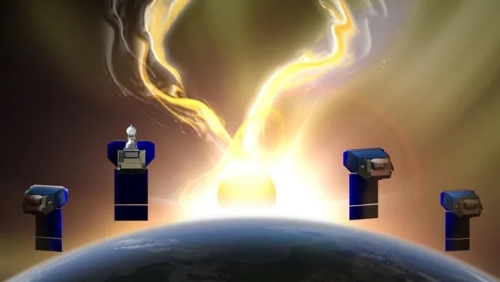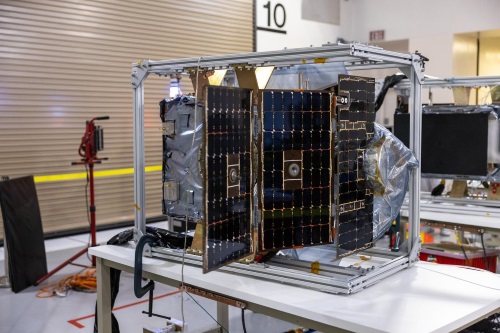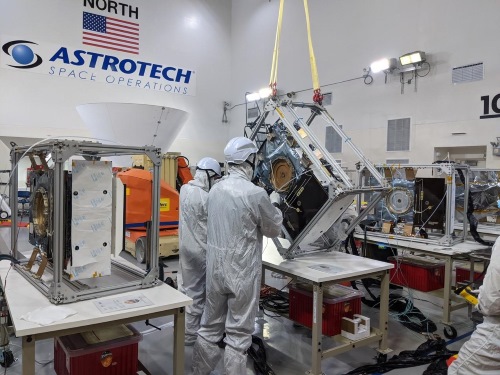NASA’s PUNCH (Polarimeter to Unify the Corona and Heliosphere) mission is a groundbreaking space mission designed to study the Sun’s outer atmosphere, known as the corona, and its expansion into the solar wind. Scheduled for launch in 2025, PUNCH consists of a fleet of four small satellites that will work together to provide an unprecedented, continuous panoramic view of the solar wind as it flows from the Sun into interplanetary space.
Heads up, the PUNCH telecon is tomorrow at 2pm ET! 👇
— NASA Sun & Space (@NASASun) February 3, 2025
Media can register by 12pm ET on Feb. 4 to participate: https://t.co/5G45jriXxn https://t.co/bWIEqEbUYO
In this article, we will understand in detail about the PUNCH mission, its features, objectives, and significance.
Overview
PUNCH, or the Polarimeter to UNify the Corona and Heliosphere, is a SmallSat mission designed to capture continuous imaging of the Sun’s corona and its transformation into the solar wind. The mission, led by Southwest Research Institute (SwRI) and NASA, is scheduled to launch aboard a SpaceX Falcon 9 on February 27, 2025, from Vandenberg Space Force Base, California. Positioned in Low Earth Orbit (LEO), PUNCH will offer unprecedented data to help refine space weather models.

Source: NASA
| Mission Name | Polarimeter to Unify the Corona and Heliosphere (PUNCH) |
| Type | Small Satellite (SmallSats) Mission |
| Launch Date | No Earlier Than February 27, 2025 |
| Launch Vehicle | SpaceX Falcon 9 (Rideshare with NASA’s SPHEREx) |
| Launch Location | Vandenberg Space Force Base, California |
| Orbit | Low Earth Orbit (LEO) |
| Lead Organization | Southwest Research Institute (SwRI), NASA |
| Primary Focus | Studying the transition from the Sun’s corona to the solar wind |

Source: NASA
Also Read| Asteroid 2024 YR4 on NASA's Radar: What Are Near Earth Objects (NEOs)?
Also Read| What is Blue Ghost Lander? Check Its Objective and Significance in Details
Mission Objectives
The PUNCH mission is designed to advance our knowledge of solar physics and space weather by focusing on key scientific goals. The main objectives of Punch Missions are to understand the Sun’s Atmosphere, map its solar structure, and enhance its predictions & tracking space weather in 3D. Let's see their objective with descriptions in detail:
| Objective | Description |
| Understanding the Sun’s Atmosphere | Observing how the Sun’s corona transitions into the solar wind. |
| Mapping Solar Structures | Studying the formation and movement of structures in the solar wind. |
| Enhancing Space Weather Prediction | Providing insights into space weather phenomena affecting Earth and space technology. |
| Tracking Space Weather in 3D | The first mission was to monitor solar events in three dimensions across the heliosphere. |
Mission Details
Innovative Approach
PUNCH employs a groundbreaking approach to studying the Sun by using a network of four suitcase-sized satellites working in unison to produce global, 3D observations of the heliosphere. The satellites will be strategically placed near Earth’s terminator line, ensuring continuous sunlight exposure for uninterrupted monitoring. PUNCH will provide a revolutionary perspective on solar wind dynamics by leveraging polarized light detection.
What will be the Scientific Goals for PUNCH (Polarimeter to UNify the Corona and Heliosphere) mission?
The mission aims to deliver continuous imaging of solar wind as it originates in the corona and extends outward through the solar system. By doing so, PUNCH will enhance understanding of solar wind structures, their evolution, and their impact on Earth’s space environment. A key focus is improving forecasts of solar storms and coronal mass ejections (CMEs), which pose risks to satellites, astronauts, and terrestrial power grids.

Source: NASA
Technology & Instruments
PUNCH is equipped with cutting-edge technology to capture dynamic solar processes in real time. The technology that was used in missions is listed below:
- Four Small Satellites: Each satellite is designed to provide specialized observations of the Sun’s outer atmosphere and solar wind structures.
- Wide Field of View: A 90° imaging field enables an unprecedented, continuous monitoring capability.
- Polarization Technology: Utilizing polarizing filters, similar to sunglasses, PUNCH will create detailed 3D maps of solar features, offering new insights into solar physics.
Flap your wings, little spacecraft! 🐥
— NASA Sun & Space (@NASASun) January 28, 2025
Engineers deployed and tested the solar arrays on NASA’s PUNCH (Polarimeter to Unify the Corona and Heliosphere) mission ahead of its launch next month from the Vandenberg Space Force Base in California.
More: https://t.co/Bp8wvZT6BT pic.twitter.com/TOuMR782L3
PUNCH Mission and Its Role in Understanding Space Weather
PUNCH mission will play a critical role in advancing our understanding of space weather, which refers to the changing conditions in space caused by solar activity. Space weather is primarily driven by the solar wind, coronal mass ejections (CMEs), and high-energy solar radiation, all of which can impact Earth’s magnetosphere, satellites, GPS systems, and even power grids.
PUNCH consists of four small satellites that will work together to continuously observe the transition of the solar corona into the solar wind.
| Impact Area | Potential Effects |
| Earth’s Atmosphere | Intensified auroras, radiation exposure risk. |
| Satellites & Communication | Disruptions in GPS, radio, and satellite operations. |
| Power Grids | Potential blackouts due to geomagnetic storms. |
| Astronaut Safety | Increased radiation risks for crewed space missions. |
Pre-Launch Preparations
To ensure a successful mission, rigorous pre-launch tests and preparations are being conducted by NASA Technicians. The Solar Array Testing conducted by Engineers at Astrotech Space Operations, Vandenberg Space Force Base, have successfully tested the solar arrays to ensure proper functionality in space. For the Cleanroom Environment, PUNCH is housed in a strict contamination-free cleanroom to protect its delicate instruments. This mission was integrated with Falcon 9 satellites which will be deployed as a secondary payload alongside NASA’s SPHEREx mission.
Why PUNCH Matters?
The PUNCH mission is a major step forward in unifying solar physics and solar wind physics. By continuously monitoring the Sun’s influence on the heliosphere, it will offer a comprehensive, real-time view of solar wind dynamics. This research is expected to greatly enhance space weather forecasting, reducing risks to satellites, astronauts, and critical infrastructure on Earth.
Conclusion
NASA’s PUNCH mission is poised to provide groundbreaking insights into the Sun’s influence on the solar system. By continuously monitoring the transition from the corona to the solar wind, PUNCH will help scientists predict and mitigate space weather disruptions, ensuring the safety of both technology and human spaceflight.
Comments
All Comments (0)
Join the conversation